Sedum Karl - growing on a personal plot
Sedum Carl (Sedum spectabile hybrida Carl) is a hybrid variety of stonecrop of Vidnoye, it is massively used for ennobling summer cottages. Loved by many growers due to its interesting appearance and extremely high vitality. The people are called hare grass. It is considered prominent due to its rich flowering, which makes the culture a real decoration of the garden.
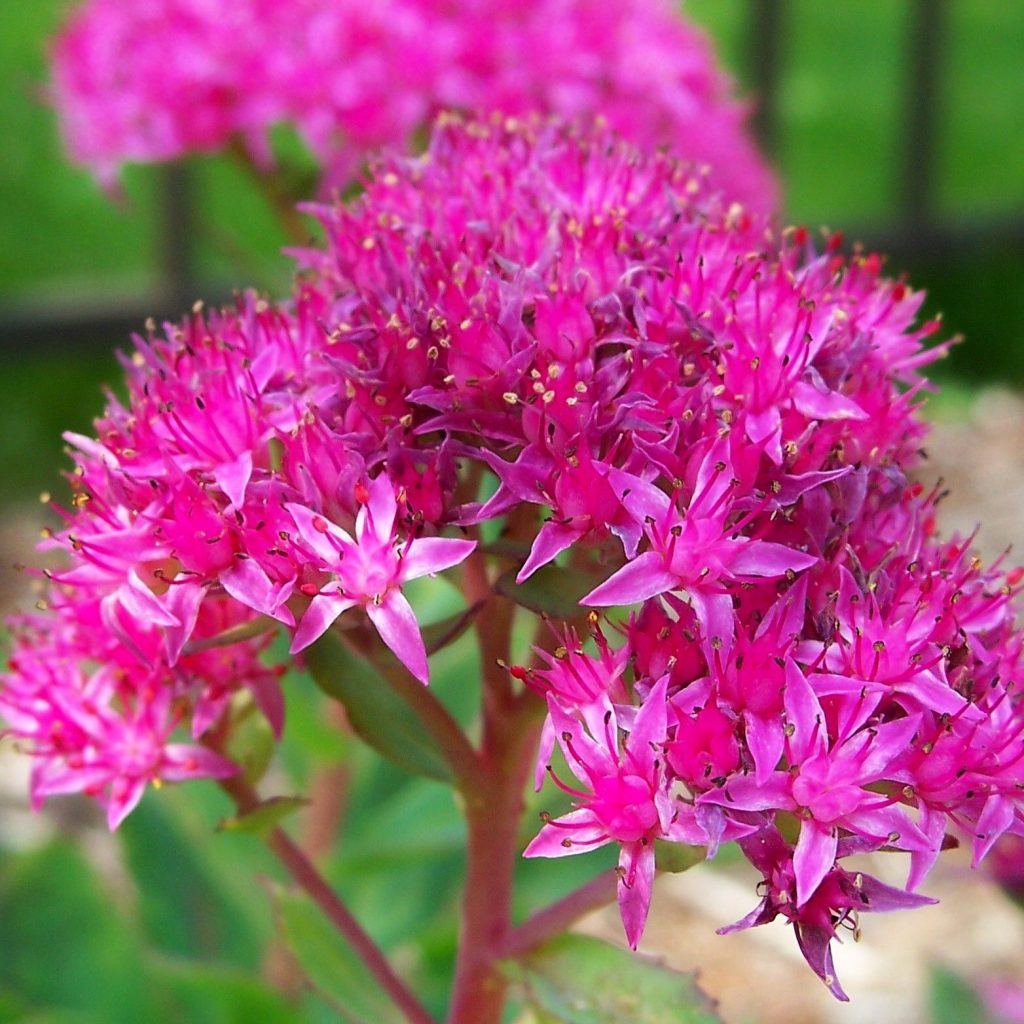
Carl sedum landing and care
Description
Sedum Vidny Karl is a perennial succulent plant, belongs to the Tolstyankov family. In its natural range, it is distributed in Japan, Korea, some regions of China, Africa, the Caucasus, the Far East and Siberia.
Prefers to settle in rocky, rocky areas, sometimes found in meadows. It is represented by a ground cover shrub. Vegetative shoots about 50 cm long, form dense neat thickets that do not clog the surrounding space.
Fleshy shoots are densely covered with juicy leaves that can accumulate a large amount of liquid. The leaf plates are oval in shape, slightly oblong with characteristic notches along the edge.
In the flowering phase, in August-October, it produces large umbellate inflorescences up to 15 cm in diameter.
The color of the buds is light pink, similar to another subspecies of Sedum - Sedum album Coral Carpet.
Growing features
Sedum Vidny is an unpretentious ornamental shrub. However, in order to achieve abundant flowering and attractiveness, all requirements regarding growing conditions should be taken into account.
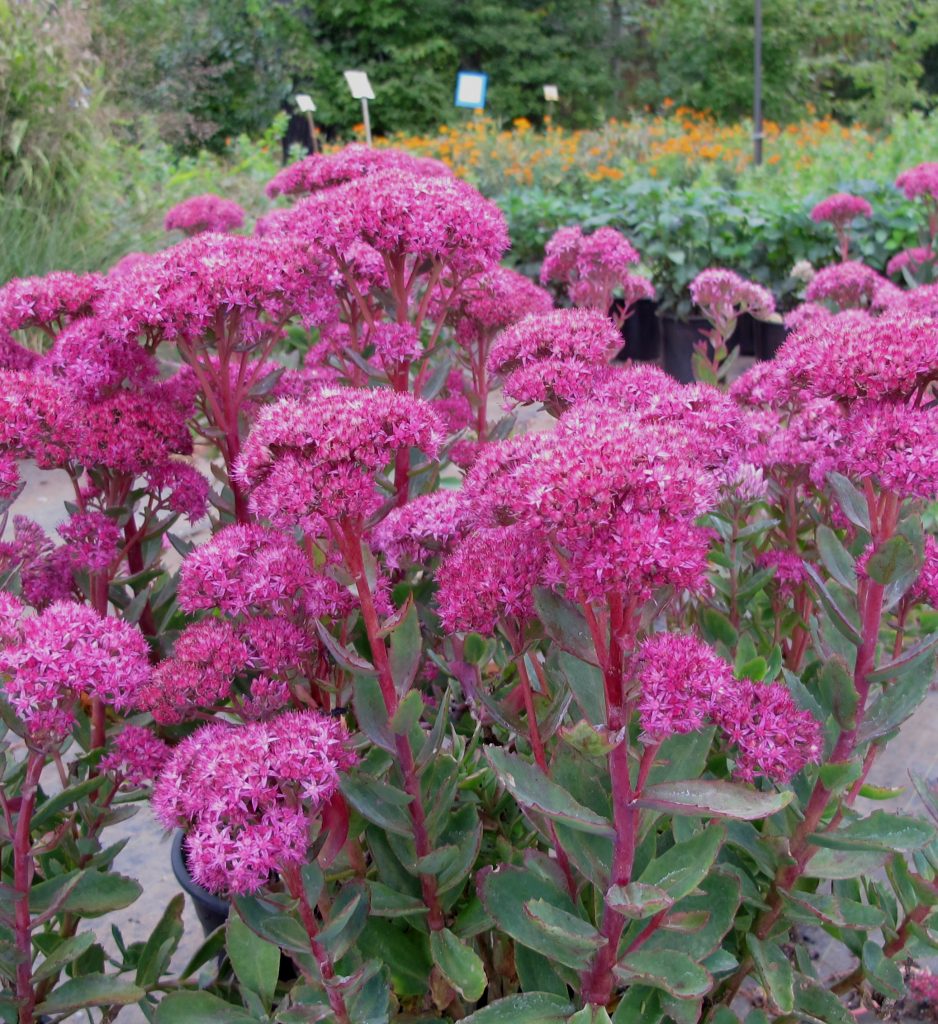
Carl sedum photo
Selection of soil and location
Sedum Karl, like all representatives of the species, is one of the light-loving plants. Therefore, it is optimal to place it in the most open area of the garden, not shaded by fruit trees and buildings.
If you plant a succulent in close proximity to shrubs, foliage that has fallen in autumn will hinder further development.
Even at the height of summer, there is no need to shade the bush. In order for the plant to receive the required amount of light, it is recommended to wipe the leaf plates from dust with a damp cloth.
For full growth, the culture requires at least 6-8 hours of exposure to the sun.
Despite the fact that the flower is found in the wild even in mountainous areas with scarce land, at home it should choose the right substrate. It is strictly forbidden to use dense soil, planting in such a soil leads to a decrease in decorative qualities. If clay prevails on the site, it is diluted with perlite or vermiculite.
The optimal composition of the soil mixture:
- river sand (1 part);
- garden turf (2 parts);
- vegetable humus / compost (1 part).
Additionally, a drainage layer is made in the seedling hole; crushed brick or expanded clay is suitable as a material.In its absence, there is a risk of moisture stagnation, which has a detrimental effect on the condition of the plant and can lead to death.
Watering and moisture
There is no need to create specific moisture parameters. Sedum feels quite comfortable in dry climates. In summer, in strong, heat, rare spraying of green mass is allowed.
Water the plant in moderation - in the growing season 1 time per month when kept in a pot. On average, a flowerpot with a volume of 2 liters requires 100 ml of soft, settled water. In winter, the pots are placed on the terrace if possible and moistened according to the standard scheme.
In the open field, irrigation is done only the first time after planting. In the future, the succulent independently controls the amount of moisture. The procedure is resumed during a long absence of rain.
Top dressing
When planting the plant, organic fertilizers (compost / humus) were applied, therefore, at first, additional feeding is not done.
To improve decorativeness in the flowering or active growing season, you can fertilize the succulent with nitrogen-containing agents.
Transfer
The transplant is done in order to rejuvenate the shrub when it reaches 4-5 years of age. The procedure is carried out in early spring using the method of dividing the mother bush. The land is selected as standard, suitable for adult specimens.
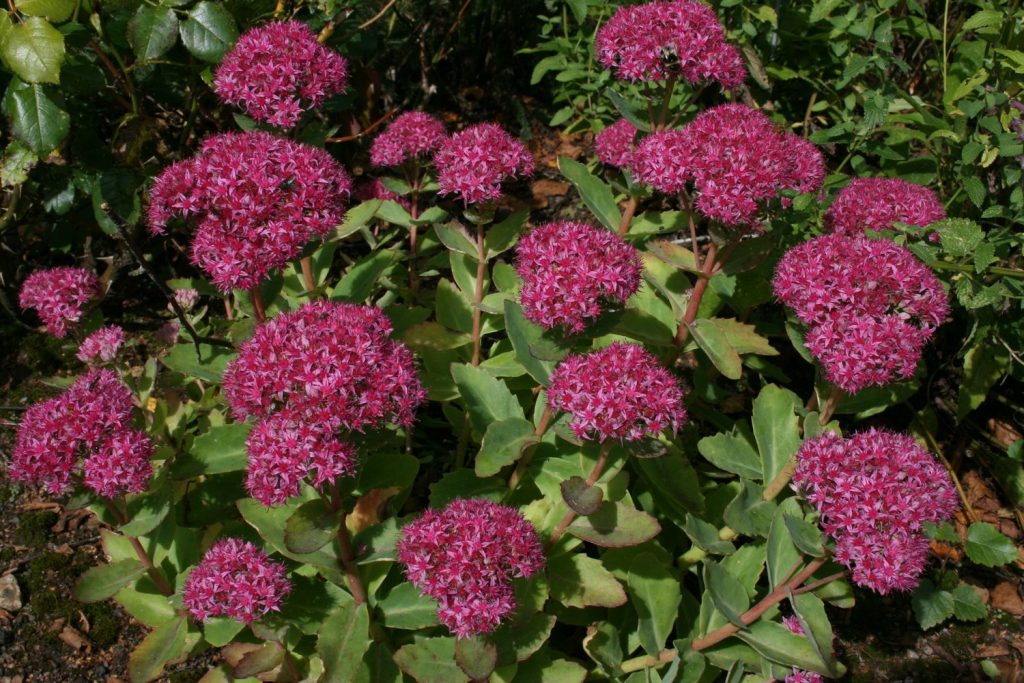
Sedum carl photo
In the course of work, a plant is dug up, the rhizome is divided into several segments so that a part of the roots and 2 developed growth buds remain on each.
Places of cuts are treated with an antifungal drug, dried for 6 hours. Then the plots are planted in the ground at a distance of 30-40 cm.
Pruning
This type of cleaning does not need pruning. The exception is situations when it is necessary to get rid of dried and injured shoots.
Weeding and loosening
Immediately after planting the succulent, the space near it is carefully weeded. On its own, especially in a young state, the plant is not able to withstand weeds. As a result of the work, soil aeration is normalized, which makes the growth of Sedum even more comfortable.
Every spring, the top layer of the substrate is additionally renewed, for this, the shrubs are carefully dug in around the perimeter.
Reproduction methods
Seeds
The most difficult method of reproduction of Sedum Vidnoe is due to the low germination of seed. During the procedure, the seeds are placed in small containers with soil, polyethylene is stretched over it and sent to the greenhouse.
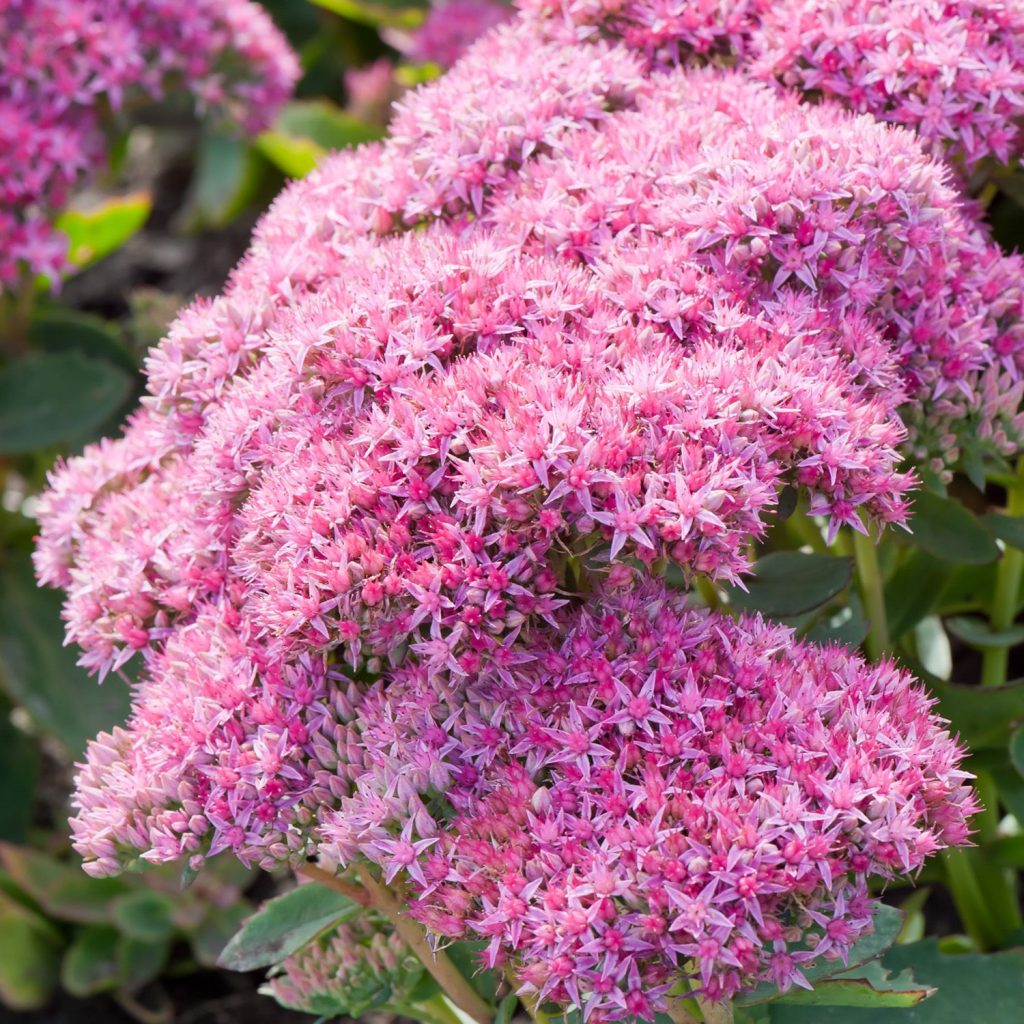
Sedum album coral carpet
After the appearance of 3 true leaves, the seedlings dive into a separate, more overall container. Flowering in this case can be observed only after 3 years.
Cuttings
One of the most effective methods, which is preferably carried out during the warm season.
Technology:
- Suitable cuttings are cut with a garden pruner, placed in a cool place for several hours to dry.
- It is deepened into the substrate by 1 cm, watered sparsely, shaded.
- They are moved to open ground no later than September, taking into account the climatic conditions of the region - the plant should be planted so that it has time to adapt before the onset of frost.
It is also allowed to pre-place the sprout in water, in which it will remain until the roots appear, after which it is transferred to a moist, compacted soil.
By dividing a bush or rhizome
A prerequisite for the event is an adult healthy bush. With the help of a shovel, it is carefully removed from the ground, with a pruner or a sharp knife, it is divided into the required number of parts, leaving growth buds and roots on each. Dry for 5-6 hours, then determine to a permanent place.
To protect the plant from possible diseases, the cuts are sprinkled with crushed activated carbon or wood ash.
Diseases and pests
| Problem | Symptoms | Prophylaxis | Treatment |
| Rot | Succulent tissues acquire a brown hue, shoots and leaves soften, covered with a grayish thick bloom. | When planting, they are placed at a sufficient distance, because one of the causes of the disease is the thickening of the plants. When leaving, they try to avoid injury to the flower. They strictly adhere to the irrigation scheme. Every 2 weeks they are treated with preparations containing copper (with the exception of the flowering period) - Abiga-Peak, Ordan or Oksikhom. | The affected segments are eliminated, cutting off 10 cm below the visible traces of the disease, and burned. Pour Profit Gold, a solution from which is made in a ratio of 5 g per 10 liters of liquid (200 ml of the product is enough for a bush). |
| Aphid | Deformation of the apical shoots, twisted leaves, sticky bloom, nodules form on the surface. | Lavender or nasturtium is planted in the immediate vicinity. They adhere to a balanced feeding rate - most often aphids settle on overfed specimens. The soil is regularly loosened and mulched. Protect the plant from the appearance of ants, which are carriers of harmful insects. | They are treated with contact drugs (Fufanon) or combined action (Bankol, Akarin, Aktellik). |
| Thrips | Yellow or discolored spots lead to holes in the surface. As a result, the leaves wilt and fall off. In a critical situation, a silvery bloom appears, the shoots are bent, the buds are deformed. | Weed and dispose of plant residues regularly. When transplanting and reproducing, they are planted in another place, thus observing the principle of crop rotation. | Hang up glue traps that you can make yourself. For this, castor oil, rosin, petroleum jelly and honey are mixed. After the composition is applied to plastic and stuck near the plant. They use infusions of dandelion, garlic, tomato tops, onions, celandine. Biological (Aktar, Fitoverm) or chemical preparations (Fufanon, Iskra Zolotaya, Caesar, Tarzan, Accord) are used. |
| Weevil | Affected buds do not open, darken, and subsequently dry out. | Dry and injured segments are removed, the surface is sprinkled with crushed charcoal. | Beetles are collected by hand. Sprayed with walnut infusion (300 g of leaves are boiled in 1.5 liters of water, infused for 24 hours) or treated with chemicals (Permethrin, Fufanon-Nova, Kinmiks, Bona Forte). |
Also, during the cultivation of Carl's Sedum, growers may encounter a number of problems, the occurrence of which is associated with mistakes in care:
- Lack of flowering, faded leaves, slow growth. They are the result of the location of the succulent on the north side of the site.
- Brittle stems that cannot bear the weight of the inflorescences - as a result of excessive fertilization.
- The structure of the bush becomes loose, vegetative shoots are stretched. The reason is the lack of light.
Beneficial features
Sedum Vidny is used in folk medicine. Since ancient times, it has been used as an antimicrobial agent and relieves pain syndromes.
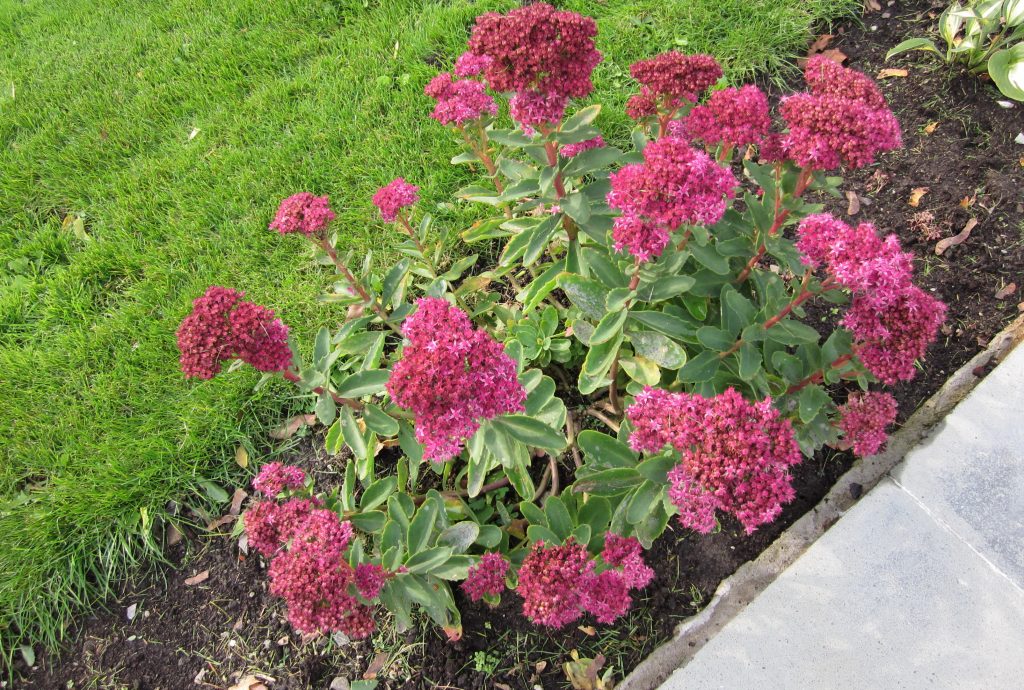
Sedum hybrid carl
It is believed that infusions based on it help to cope with the symptoms of gastrointestinal tract disorders, pulmonary insufficiency, heart problems, they also have a tonic effect and give strength.
Self-medication is not worth it - most varieties are poisonous.
Application in landscape design
Variants of using a plant in landscape design:
- Rockery. Sedum feels great even located in a flowerpot, and therefore can be used as a resident of a vessel made of stone or wood. The advantage of this modification is the ability to move around the garden in order to choose the most suitable location.
- Flower bed. In addition to the personal plot, planting in urban flower beds is allowed - the culture is highly resistant to air pollution.
- Border.Due to its sufficiently high growth, it can act as a delimiter of several functional areas.

